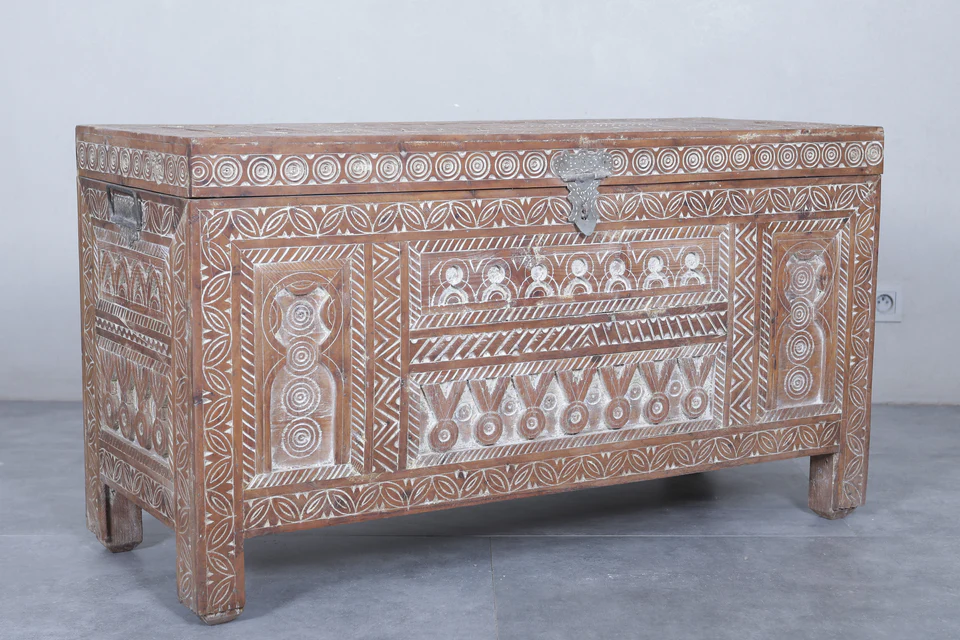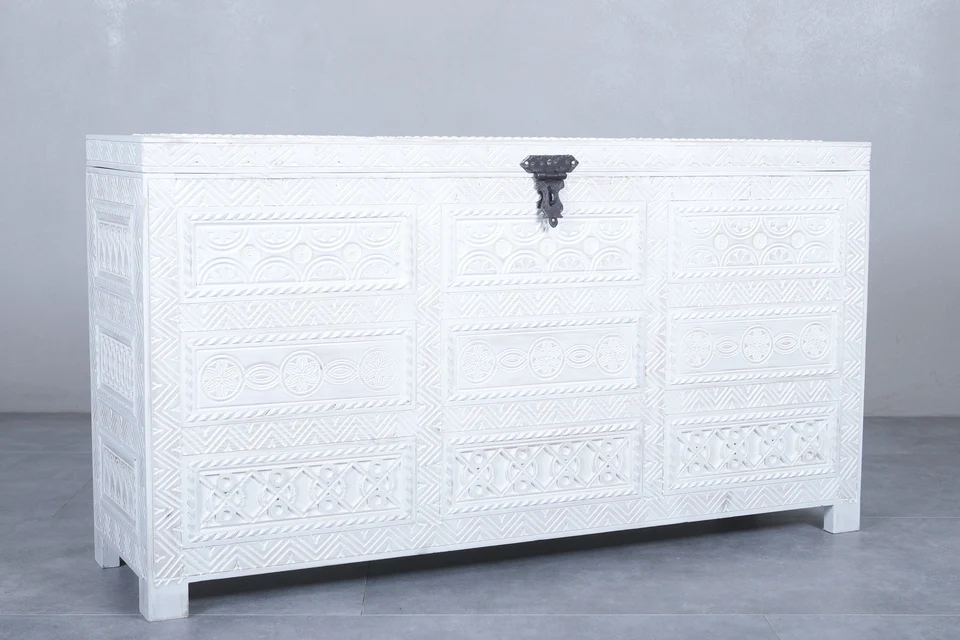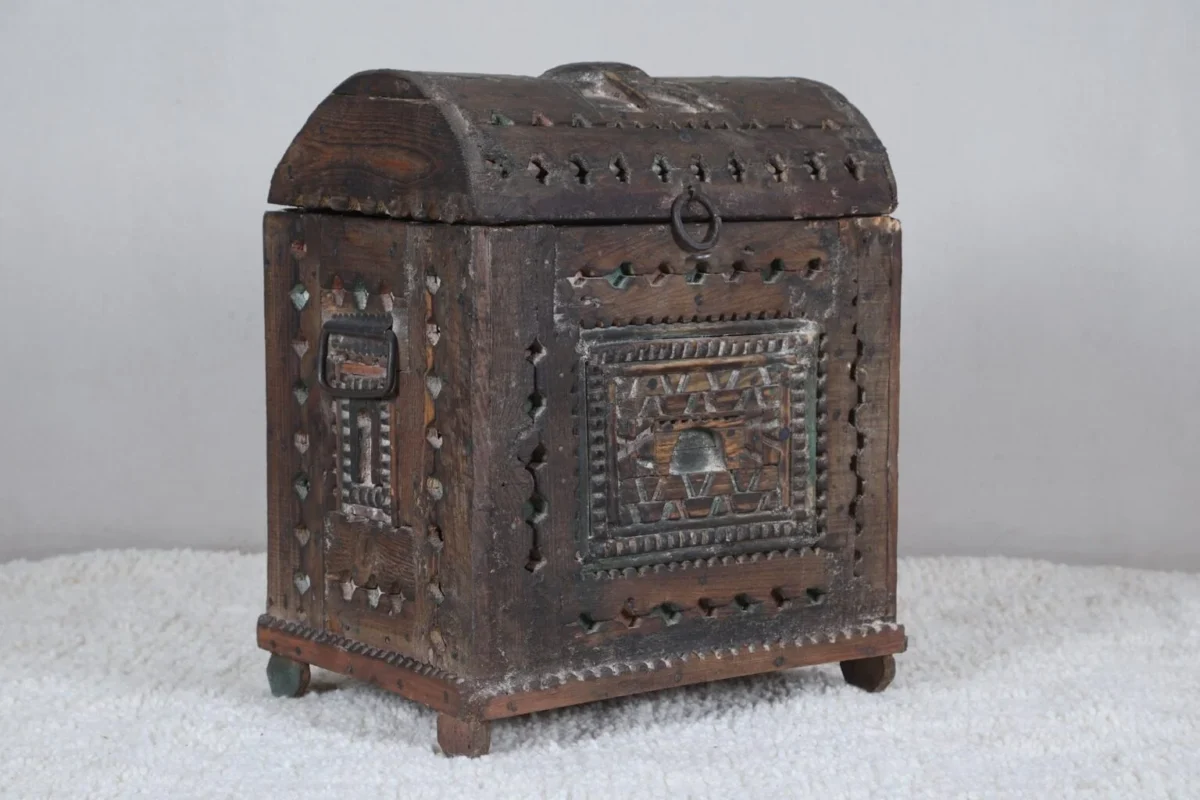Introduction to Moroccan Chests
Moroccan chests are distinguished by their rich cultural heritage and exquisite craftsmanship, making them highly sought after for both organizational and decorative purposes. These chests date back centuries and were historically utilized as secure storage solutions for valuables, clothing, and household items. Often constructed from sturdy woods such as cedar or walnut, Moroccan chests are renowned for their durability and aesthetic appeal.
One of the most striking features of Moroccan chests is their intricate design work. Artisans skillfully carve and inlay these chests with detailed geometric patterns, floral motifs, and arabesques, often incorporating materials like mother-of-pearl, bone, and brass. This meticulous craftsmanship not only showcases the artisans’ expertise but also tells the story of Morocco’s rich artistic traditions.
In addition to their functional role, Moroccan chests have seamlessly integrated into modern home decor. They are frequently used as statement pieces in various settings, such as living rooms, bedrooms, and entryways. The chests’ vibrant colors, detailed engravings, and unique shapes lend themselves well to both contemporary and traditional interiors. Whether they are employed as coffee tables, storage units, or simply as decorative accents, Moroccan chests create a sense of elegance and history in any space.
The demand for Moroccan chests has seen a resurgence in recent times, driven by a growing appreciation for artisanal craftsmanship and cultural authenticity. Collectors and interior designers alike value these pieces not only for their beauty but also for the stories and heritage they embody. As such, Moroccan chests continue to captivate and inspire, bringing a touch of exotic flair and sophisticated organization to today’s homes.
Historical Background and Craftsmanship
Moroccan chests, also known as Moroccan trunks, have a deep-rooted history that stretches back to the confluence of cultures and empires in North Africa. These chests are more than mere storage solutions; they encapsulate the essence of Moroccan artistry and cultural heritage. Historically, they have been used not only for their functional utility but also as significant decorative pieces in Moroccan homes, often passed down through generations as treasured heirlooms.
The core materials used in the creation of Moroccan chests generally include cedarwood, renowned for its durability and aromatic qualities. Cedarwood, abundant in the Atlas Mountains, is prized for its resilience against pests and its ability to preserve contents over extended periods. The wood itself is a testament to Morocco’s rich natural resources and plays a crucial role in adding to the longevity and intrinsic value of these chests.
The craftsmanship of Moroccan chests is distinguished by intricate hand-carving techniques passed down through generations. Artisans often spend months perfecting the elaborate designs that adorn these chests. Common motifs include geometric patterns, floral designs, and elements inspired by Islamic art. These patterns are not merely decorative; they embody symbolic meanings and reflect the rich tapestry of Moroccan cultural traditions.
The process of crafting a Moroccan chest involves meticulous attention to detail. Artisans start by carefully selecting and seasoning the wood to ensure its stability. Then, the intricate hand-carving begins, utilizing a combination of chisels, knives, and other specialized tools. Each chest is a unique creation, reflecting the artisan’s skill and individual style. The finishing touches often include inlays of bone, metal, or other materials, further enhancing the chest’s aesthetic appeal and cultural significance.
Thus, wood chests stand as a testament to the country’s illustrious tradition of fine woodworking and artisan craftsmanship. They not only serve as functional storage units but also as artistic representations of Morocco’s cultural richness, making them cherished pieces both in historical contexts and modern-day decor.
“`html
Styles and Designs of Moroccan Chests
Moroccan chests come in a wide array of styles and designs, each reflecting the rich cultural heritage and intricate craftsmanship of the region. From heavily ornate pieces to more minimalist designs, these chests are not just functional storage solutions but also beautiful decorative elements that can enhance any space.
Traditional Moroccan chests are often characterized by their elaborate decorations. These designs typically incorporate intricate geometric shapes, arabesques, and floral patterns. The geometry in Moroccan art is not just for aesthetics; it often holds deeper symbolic meanings, representing the infinite nature of the universe. Arabesque designs, characterized by flowing, interlacing patterns, are inspired by Islamic art and are common across many Moroccan chests. Floral patterns, on the other hand, bring a touch of nature indoors, with stylized representations of plants and flowers adding to the overall elegance.
For those who prefer a subtler approach, minimalist Moroccan chests offer a more understated elegance. These chests may still feature traditional motifs but in a more restrained manner, with less intricate detailing and simpler lines. The minimalist designs allow the natural beauty of the materials, often rich woods and metals, to shine through.
Regional variations within Morocco also influence the design and style of these chests. For example, chests from Fez are known for their detailed carving and painted decorations, often in bold colors. In contrast, chests from Marrakech may feature more elaborate metalwork, with intricate lattices and inlays. Coastal regions like Essaouira are known for incorporating marine elements and lighter, more airy designs, often using whitewashed wood to reflect the breezy seaside atmosphere.
Regardless of the specific style or origin, Moroccan chests are a testament to the country’s artistic diversity and craftsmanship. Their unique designs not only serve as functional storage solutions but also as captivating pieces of art that bring a touch of Moroccan splendor into any home.
“`
Functional Uses of Moroccan Chests
Moroccan chests are more than just exquisite pieces of furniture; they are versatile storage solutions that seamlessly blend function and style. These chests, often adorned with intricate designs and rich textures, can serve multiple purposes within a modern home.
Primarily, Moroccan chests are ideal for storing linens, such as beddings, blankets, and towels. Placing a chest at the foot of the bed not only provides a convenient spot for extra linens but also adds an element of sophistication to the bedroom decor. Similarly, these chests can be used in living areas or dining rooms to store tablecloths, napkins, and other dining accessories, ensuring that everything remains organized and easily accessible.
For those with an extensive wardrobe, Moroccan chests offer a stylish solution for clothing storage. Seasonal items, bulky sweaters, or accessories can be neatly tucked away in these chests, helping to keep the closet clutter-free while adding a decorative touch to the room. Their spacious interiors make them suitable for storing keepsakes and personal mementos, protecting cherished items while keeping them readily available.
Beyond traditional storage purposes, Moroccan chests can function as alternative furniture pieces. Their flat tops make them perfect candidates for coffee tables in a living room. By placing a tray on top, you can create a stable surface for drinks and décor while utilizing the interior for storing books, magazines, or board games. Similarly, in a media room or bedroom, a sturdily built Moroccan chest can double as a TV stand, offering both aesthetic charm and practical storage space for electronics and DVDs.
To maximize the utility and visual appeal of Moroccan chests, consider combining their storage capabilities with thoughtful placement and complementary decor. Positioning a chest alongside a well-coordinated rug or a set of matching cushions can enhance the ambiance of the room, making it a focal point that is both functional and beautiful.
“`html
Integrating Moroccan Chests into Various Decor Themes
Moroccan chests are versatile pieces that can complement a range of interior design styles. These chests, often adorned with intricate woodwork and metal detailing, serve not just as storage solutions but also as captivating focal points. In traditional interiors, Moroccan chests can blend seamlessly, adding an exotic touch that enhances the room’s old-world charm. Placed at the foot of a bed in a classic bedroom setup, or anchoring a hallway entrance, they offer both functionality and elegance.
In contemporary spaces, where minimalism and clean lines predominate, Moroccan chests provide an interesting counterbalance. Their elaborate designs can break the monotony of sleek, modern furnishings, introducing a rich, artisanal texture. Imagine a modern living room with a neutral color palette highlighted by a single, vividly painted Moroccan chest—this contrast not only draws the eye but also serves as a conversation starter, making the space feel warmer and more inviting.
Eclectic interiors, known for their mix-and-match approach, benefit significantly from the inclusion of Moroccan chests. These pieces can act as the perfect bridge between disparate elements, harmonizing varied styles and colors within a room. For instance, a living room with mid-century chairs, bohemian rugs, and industrial lighting can be beautifully tied together with a well-crafted Moroccan chest. By acting as a central piece, it can unify the eclectic assortment, creating a cohesive yet visually stimulating environment.
Additionally, Moroccan chests can shine in specific settings like nurseries or home offices. In a nursery, a chest with vibrant, hand-painted patterns can add a playful yet sophisticated touch, while in a home office, it can provide practical storage for documents while elevating the room’s aesthetic appeal. Ultimately, Moroccan chests are not just furniture but functional art pieces that can seamlessly integrate into diverse decor themes, enhancing both form and function in any space.
“`
Maintenance and Care for Moroccan Chests
Proper maintenance and care are essential to preserve the beauty and functionality of Moroccan chests. These exquisite pieces often feature intricate wood carvings and embellishments, requiring considered attention to maintain their allure. Regular cleaning is foundational in ensuring the longevity of Moroccan chests. Using a soft, dry cloth to gently dust the surface removes particulates that may scratch the wood or settle in the carvings. Avoid using water or chemical cleaners, as these can damage the finish and the delicate details.
Polishing is another key aspect of maintaining Moroccan chests. It is best to use a high-quality, non-abrasive wax or polish made specifically for wood furniture. Apply the polish in small amounts, using a soft cloth to rub it into the wood gently, enhancing the luster and providing a protective layer against minor scratches and wear.
Protection extends beyond routine cleaning and polishing. Moroccan chests should be kept in a stable environment to prevent damage from fluctuating humidity and temperature. Excess moisture can lead to wood warping or mold growth, while overly dry conditions may cause the wood to crack. Placing the chest in a room with controlled humidity, and away from direct sunlight or heat sources, can help mitigate these risks. Additionally, using protective coasters or pads under items placed on the chest can prevent surface damage.
Guarding against pests is also crucial. Borer insects, for instance, can severely damage wooden furniture. Regularly inspecting the chest for any signs of pest activity and addressing any issues promptly will help in preserving the chest. To deter insects, natural alternatives like cedar blocks or lavender sachets can be placed inside the chest, providing a pleasant aroma while protecting the wood.
Incorporating these maintenance practices will help ensure that Moroccan chests remain not only stylish and decorative but also functional and durable for years to come.
Where to Buy Authentic Moroccan Chests
When it comes to purchasing an authentic Moroccan chest, ensuring the authenticity and quality of the piece is paramount. The first step is to identify reputable vendors, whether you are shopping online or offline. Notable online platforms such as Amazon, eBay, and dedicated artisanal websites like Morocco Handmade offer a variety of genuine Moroccan chests. These platforms often feature detailed product descriptions, customer reviews, and seller ratings, which can be invaluable tools in assessing the authenticity and craftsmanship of the chests.
For those who prefer to examine the chests in person, visiting specialty furniture stores or markets known for Moroccan imports can be an excellent option. Stores such as World Market or local antique shops often carry authentic Moroccan furniture and decor, including chests. When purchasing offline, closely inspecting the chest for signs of genuine handcraftsmanship is essential. Authentic Moroccan chests often feature intricate woodwork, detailed carvings, and high-quality materials like cedar or thuya wood.
Price is another critical factor to consider. Moroccan chests vary widely in price depending on their size, material, and intricacy of design. Smaller, simpler chests might be available for a few hundred dollars, while larger pieces with more elaborate designs can cost several thousand dollars. It is important to recognize that significantly lower-priced items may be indicative of counterfeit products or inferior craftsmanship.
To avoid counterfeit products, attention to detail is crucial. Authentic Moroccan chests often display fine craftsmanship, including hand-carved patterns and traditional Moroccan motifs such as geometric designs or floral accents. Additionally, genuine chests will typically possess a distinct aroma from the quality wood used in their construction.
In conclusion, whether shopping online or in-person, verifying the authenticity and quality of a Moroccan chest requires a keen eye and careful consideration of the vendor’s reputation, price, and the craftsmanship on display. By keeping these factors in mind, one can confidently purchase a stunning and genuine Moroccan chest that adds both organizational utility and aesthetic beauty to any space.
DIY Ideas and Customization Tips
For those interested in adding a personal touch to their Moroccan chests, there are various DIY customization options that can not only enhance the beauty of these pieces but also imbue them with unique character. A popular method is to apply a new paint finish. By selecting a color scheme that harmonizes with your interior decor, you can seamlessly integrate the chest into your living space. Ensure that the chosen paint complements the intricate designs and motifs inherent to Moroccan craftsmanship.
Another engaging project involves enhancing the carvings with gold leaf. This technique elevates the ornate patterns, adding a touch of opulence and sophistication. Apply the gold leaf carefully, ensuring it adheres well to the carved recesses. This not only accentuates the delicate details but also balances traditional aesthetics with a touch of luxury.
Modern elements, such as metal hardware, can also be integrated to enrich the traditional motif of Moroccan chests. Consider swapping out existing handles and hinges for more contemporary options. Metals like brass or wrought iron can provide a striking contrast, marrying antique charm with modern elegance. Opt for designs that are subtly intricate to maintain the chest’s artistic integrity while providing a fresh look.
Don’t hesitate to get creative with fabric and upholstery as well. Lining the interior of the chest with rich textiles, such as velvet or brocade, can add an extra layer of extravagance. This not only protects the contents but also introduces additional texture and color to the piece.
When customizing Moroccan chests, it’s crucial to respect the traditional craftsmanship and materials. While adding personal touches, keeping the essence of Moroccan artistry intact ensures that the chest remains a timeless treasure, enhancing both its aesthetic and functional value.




